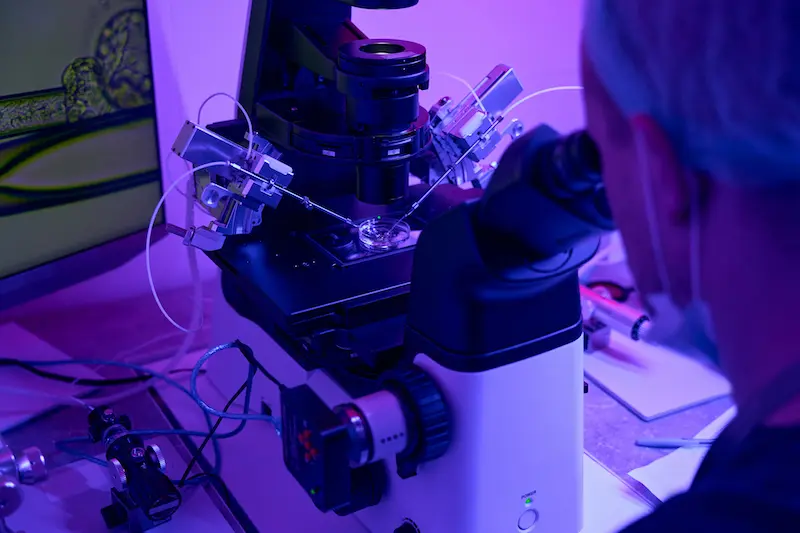In assisted reproductive technology, Preimplantation Genetic Testing (PGT) has emerged as a crucial tool in the in vitro fertilization (IVF) treatment. PGT testing allows for the screening and diagnosis of genetic abnormalities in embryos before they are transferred to the uterus, increasing the pregnancy success rates and minimizing the risk of genetic disorders. This article will dive into the details of PGT testing, exploring its history, benefits, different types available, accuracy and reliability, role in reducing the risk of genetic disorders, impact on IVF success rates, cost and insurance coverage, ethical considerations, future developments, and frequently asked questions.
Key Takeaways
- PGT testing is a genetic screening tool used in IVF treatment to identify congenital abnormalities in embryos before implantation.
- Different types of PGT testing are available, including PGT-A, PGT-M, and PGT-SR, each with its specific purpose.
- PGT testing can reduce the risk of genetic disorders in offspring and improve IVF success rates.
- The accuracy and reliability of PGT testing have improved over time, making it a valuable tool in IVF treatment.
- While PGT testing can be costly and raises ethical considerations, it will likely continue to play a significant role in the future of IVF treatment.
What is PGT Testing and How Does it Work?
Preimplantation Genetic Testing (PGT) is a laboratory technique used to analyze the genetic makeup of embryos created through IVF treatment. It involves extracting a few cells from an embryo at the blastocyst stage, typically around five to seven days after fertilization. These cells are then analyzed for any genetic abnormalities or chromosomal disorders.
The process of PGT testing begins with embryo biopsy and removing a small sample of cells from the embryo. This sample undergoes various genetic analysis techniques such as polymerase chain reaction (PCR), fluorescence in situ hybridization (FISH), comparative genomic hybridization (CGH), or next-generation sequencing (NGS). These techniques allow for detecting specific genetic abnormalities or chromosomal disorders in the embryo. Once the analysis is complete, the embryos are graded based on their genetic health, and only those deemed to have a higher chance of successful implantation and development are chosen for transfer to the uterus.
The History of PGT Testing in IVF Treatment
The history of PGT testing in IVF treatment dates back to the early 1990s when scientists first began exploring the possibility of screening embryos for genetic abnormalities. The initial focus was on identifying chromosomal disorders such as Down syndrome, which results from an extra copy of chromosome 21. Over the years, technological advancements and an understanding of genetics have led to developing more sophisticated PGT testing methods.
One of the significant milestones in developing PGT testing was the introduction of FISH in the late 1990s. FISH detects specific chromosomal abnormalities by using fluorescent probes that bind to particular DNA sequences. This technique revolutionized PGT testing by enabling the screening of embryos for a range of genetic disorders.
Another milestone in PGT testing came with the advent of CGH in the early 2000s. CGH allowed for a comprehensive analysis of all 23 pairs of chromosomes, providing a more accurate assessment of genetic health. This technique paved the way for more precise embryo selection and improved IVF success rates.

The Benefits of PGT Testing for IVF Patients
| Benefit | Description |
| Increased Pregnancy Rates | PGT testing can identify embryos with chromosomal abnormalities, leading to higher pregnancy rates and lower miscarriage rates. |
| Reduced Risk of Genetic Disorders | PGT testing can identify embryos with genetic disorders, allowing for the selection of healthy embryos and reducing the risk of passing genetic disorders to offspring. |
| Reduced Need for Multiple Embryo Transfers | PGT testing can identify the most viable embryos, reducing the need for multiple embryo transfers and the associated risks and costs. |
| Improved Patient Satisfaction | PGT testing can provide peace of mind for patients, knowing that they have selected the healthiest embryos for transfer. |
PGT testing offers numerous benefits to couples undergoing IVF treatment. Firstly, it significantly improves the chances of a successful pregnancy. By selecting embryos with a higher likelihood of implantation and normal development, PGT testing increases the probability of achieving a healthy pregnancy and live birth.
Secondly, PGT testing reduces the risk of genetic disorders in offspring. By identifying embryos with chromosomal abnormalities or specific genetic mutations, couples can make informed decisions about which embryos to transfer, minimizing the chances of passing on genetic disorders to their children.
Lastly, PGT testing provides couples with increased confidence in embryo selection. By having access to detailed information about the genetic health of their embryos, couples and individuals can decide which embryos to transfer, reducing anxiety and uncertainty during the IVF process.
The Different Types of PGT Testing Available
Several types of PGT testing are available, each with its specific purpose and methodology. Preimplantation Genetic Screening (PGS) is used to screen embryos for chromosomal abnormalities, such as aneuploidy (an abnormal number of chromosomes). PGS is particularly beneficial for couples or individuals with a history of recurrent miscarriages or at a higher maternal age, as these factors increase the likelihood of chromosomal abnormalities in embryos.
On the other hand, Preimplantation Genetic Diagnosis (PGD) is used to diagnose specific genetic disorders in embryos. PGD is best for couples with genetic mutations or a family history of a particular genetic disorder. By identifying embryos affected by the disorder, couples and individuals can make informed embryo selections, reducing the risk of passing on their genetic disorders to their children.
Comparative Genomic Hybridization (CGH) is a technique used in PGT testing to analyze the entire genome of an embryo. CGH provides a comprehensive assessment of all 23 pairs of chromosomes, allowing for the detection of both numerical and structural chromosomal abnormalities. This technique has significantly improved the accuracy and reliability of PGT testing.
Next-generation sequencing (NGS) is a cutting-edge technology revolutionizing PGT testing. NGS allows for the rapid and cost-effective analysis of multiple genes simultaneously, making it an ideal tool for comprehensive genetic screening and diagnosis. NGS has further enhanced the accuracy and efficiency of PGT testing, enabling more precise embryo selection.
The Accuracy and Reliability of PGT Testing
The accuracy and reliability of PGT testing are crucial factors in its success as a diagnostic tool in IVF treatment. The accuracy of PGT testing is typically measured by its ability to identify embryos with or without genetic abnormalities correctly. Studies have shown that PGT testing has a high level of accuracy, with reported rates ranging from 95% to 99%.
The reliability of PGT testing depends on several factors, including the biopsy's quality, the genetic analysis technique's accuracy, and the laboratory's expertise in performing the testing. Couples must choose a reputable and experienced laboratory for PGT testing to ensure reliable results.
While PGT testing is highly accurate, it could be more foolproof. Any diagnostic test, including PGT testing, has a small margin of error. Additionally, PGT testing cannot detect all genetic abnormalities or guarantee a successful pregnancy. However, it significantly improves the chances of a successful pregnancy and does reduce the risk of genetic disorders.
The Role of PGT Testing in Reducing the Risk of Genetic Disorders
One of the primary benefits of PGT testing is its ability to reduce the risk of genetic disorders in offspring. By identifying embryos affected by specific genetic mutations or chromosomal abnormalities, couples can make informed decisions about which embryos to transfer, minimizing the chances of passing genetic disorders to their children.
PGT testing can detect genetic disorders, including single-gene disorders such as cystic fibrosis, sickle cell anemia, and Huntington's disease. It can also identify chromosomal abnormalities such as Down, Turner, and Klinefelter. By identifying embryos affected by these disorders, couples can choose embryos free from genetic abnormalities, significantly reducing the risk of having a child with a genetic disorder.
The Impact of PGT Testing on IVF Success Rates
PGT testing has significantly impacted IVF success rates. By selecting embryos with a higher likelihood of implantation and normal development, PGT testing increases the chances of having a successful pregnancy and live birth.
Studies have shown that PGT testing can improve IVF success rates by up to 30%. This improvement is due to the ability to select genetically healthy embryos with a higher potential for implantation and development. Transferring only the most viable embryos enhances IVF success rates.
Furthermore, PGT testing reduces the risk of implanting embryos with chromosomal abnormalities, which are less likely to result in a successful pregnancy. By screening embryos for aneuploidy and other chromosomal abnormalities, PGT testing ensures that only genetically healthy embryos transfer to the uterus, further improving IVF success rates.
The Cost of PGT Testing and Insurance Coverage
The cost of PGT testing can vary depending on many factors, including the type of testing performed, the number of embryos tested, and the laboratory conducting the testing. On average, PGT testing can cost anywhere from $3,000 to $6,000 per cycle.
Insurance companies may only sometimes cover PGT testing. While some insurance plans may provide coverage for PGT testing, others may consider it an elective procedure and not cover the costs.
Frequently Asked Questions About PGT Testing in IVF
- Is PGT testing necessary for all couples undergoing IVF?
PGT testing is not necessary for all couples undergoing IVF. It is typically best for couples with a history of genetic disorders or chromosomal abnormalities, advanced maternal age, or recurrent miscarriages. - Does PGT testing guarantee a successful pregnancy?
While PGT testing significantly improves the chances of a successful pregnancy, it does not guarantee a successful outcome. Several factors, including the quality of the embryos, the age of the woman, and other individual characteristics, can influence the success of IVF treatment. - Can PGT testing determine the gender of embryos?
Yes, PGT testing can determine the gender of embryos. However, it is essential to note that gender selection for non-medical reasons is considered controversial and may not be available in all countries or clinics. - How long does it take to get the results of PGT testing?
The time it takes to receive the results of PGT testing can vary depending on the laboratory and the specific testing method used. In general, results are typically available within one to two weeks.
- Protecting Your Health: Choosing A Sperm Bank Over Natural Insemination
- Hatching a Plan: Learning The Basics About Assisted Hatching in IVF
- Navigating GYN Surgery Before Artificial Insemination
- PGT Testing and Its Role in IVF Treatment
- The Ultimate Guide To Where You Can Donate Sperm In All 50 States

